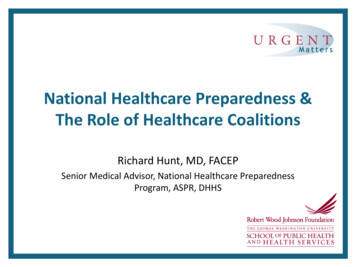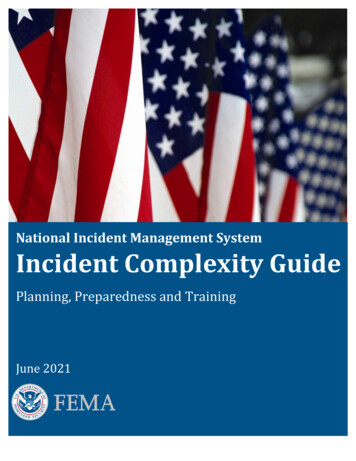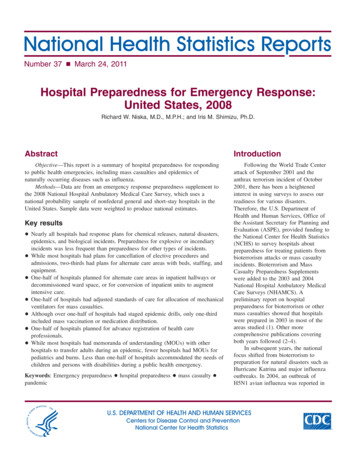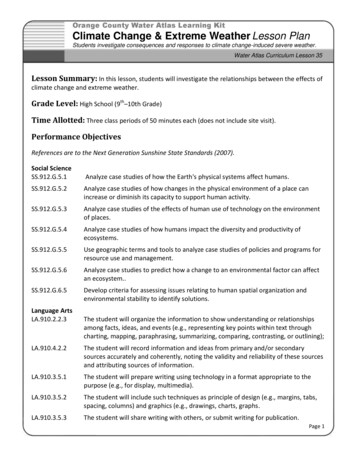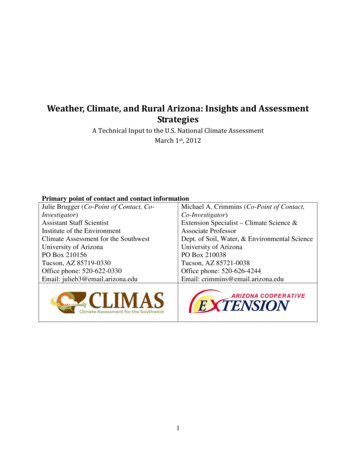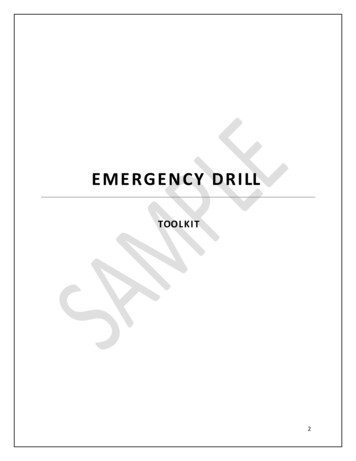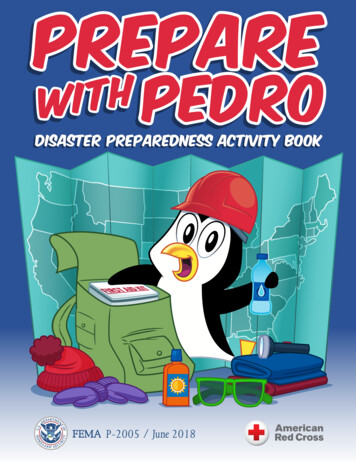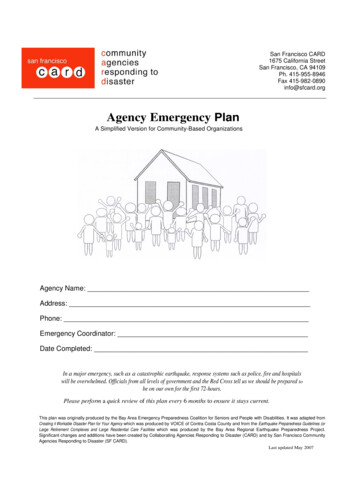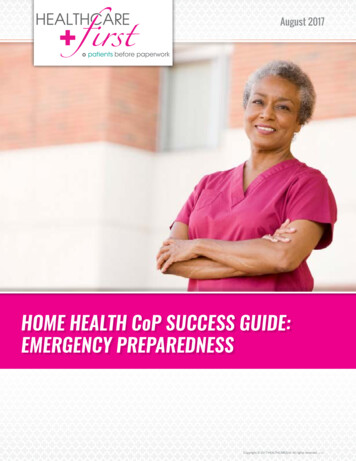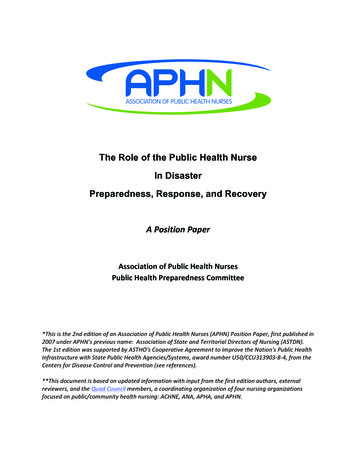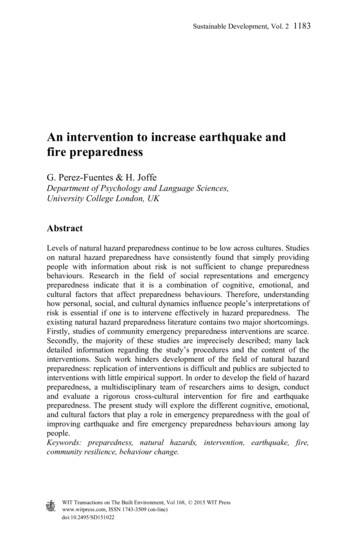
Transcription
Dispatcher TrainingWorking with the National Weather ServiceClarke County May 11, 2014Tama/Jasper CountyJuly 6, 2014All Photos CourtesyKCCI uLocal PageRockwell City June 30, 2014
Dispatcher Training The National Weather Service (NWS)Our role and servicesSevere weather 101What the NWS needs to know from dispatchersWhen to contact the NWSOptimizing communicationCase Study
The National Weather ServiceWho we Are Federal governmentweather forecast agencyWho we Serve United States & Territories Five Offices Serve IowaPrimary Mission Provide weather warnings for theprotection of life and propertyAs a dispatcher, you help usaccomplish this mission!
The National Weather ServiceOffice Staffing and Operations Total staff of 23 people24 hour shift coverageRotating shiftsProvides continuouswarning and forecastservices
Our Role and ServicesNational Weather ServiceMission Statement"The National Weather Service(NWS) provides weather,hydrologic, and climate forecastsand warnings for the United States,its territories, adjacent waters andocean areas, for the protection oflife and property and theenhancement of the nationaleconomy.”
Our Role and Services We can’t stop storms! We can’t knock onevery door and tellthem it’s coming! What can we do?How can we protect property and save lives?
Our Role and Services Preparedness Forecast and warningservices Dissemination ofemergency messagesOur goal is for people to make informedand educated decisions for themselves!
NWS Websitewww.weather.gov/desmoines“One Stop Shop” Access to all outlooks,watches, and warnings Submit spotter reports Can view radar datawith warning polygons Seven day forecast and much more
Forecast Services Gridded Forecasts forthe entire United States National Digital ForecastDatabase (NDFD) All “worded” forecastsfall out of the NDFD NWS Website for bestaccessPoint and ClickForecast
Watches and WarningsWinter and Non-Precipitation Watch/Warning/Advisory ServicesHeadlineOverview SectionEach segment has a listing of countiesand cities – best viewed graphicallyShort Term TrendsStorm InformationImpacts and Call to Actions
Warning Services TimelineWarningWatch- Minutes- Hours to minutesOutlook- Days to hours
Severe Weather Warning TextWarning text describes impacts anduses “tags” to make importantinformation easier to findTornado Warning TagTORNADO.RADARINDICATEDEvidence on radar is supportiveof a tornado, but there is noground confirmation.TORNADO.OBSERVEDTornado is confirmed byspotters, law enforcement, etc.Tornado Warning Damage Threat TagNo TagUsed most of the time whentornado damage is possible.TORNADO DAMAGETHREAT.CONSIDERABLEUsed rarely when there iscredible evidence that atornado is capable of producingconsiderable damage.TORNADO DAMAGETHREAT.CATASTROPHICUsed exceedingly rarely when asevere threat to human life andcatastrophic damage from atornado is occurring.Tornado Tag In Severe Thunderstorm WarningsTORNADO.POSSIBLEA severe thunderstorm hassome potential to produce atornado
Tornado Warning TextTornado Warnings Tornado (also implies severe wind/hail possible)Counties – best viewed graphicallyBasis, location and movementHazard, source and impactsLocations (city list or pathcastCall to ActionsTags
Severe T-Storm Warning TextSevere Thunderstorm Warnings – 1 inch hail and/or 58 mph windsCounties – best viewed graphicallyBasis, location and movementHazard, source and impactsImpacted locations (city list or pathcastCall to ActionsMax wind/hail tag
Severe Wx Statement TextFollow-up Severe Weather Statement Additional detail to a warningBasis, location and movementHazard, source and impactsLocations (city list or pathcastCall to ActionsTags
Flash Flood Warning TextFlash Flood Warnings – Imminent or occurringCounties – best viewed graphicallyBasis, location and movementImpacted locations (city list and/or streamsCall to Actions
Warning Text“Emergencies” Tornado Emergency – A destructiveconfirmed tornado which will likelymove into a populated area resultingin serious property damage and a highpotential for loss of life! Catastrophictag! Flash Flood – A serious flash floodwhich will likely cause severe damageand a high potential for loss of life!
Severe Weather 101What is a Tornado? A violently rotating column of airattached to a cloud base and incontact with the ground. Exhibit rapid rotation and aremost often laminar or smooth inappearance Can have visible and invisiblefunnels Usually vertically orientedCourtesy of Jeff & Amy Ruhland
Severe Weather 101Tornado Types and Terms Wedge – Large tornado Invisible – A tornado without acondensation funnel Funnel – Rotating column of air NOTon the ground EF Rating – Enhanced Fujita ratingwhich indicates a tornadoes strengthInvisible TornadoFunnel CloudCourtesy of Jeff & Amy RuhlandWedgeTornadoRain-Wrapped TornadoCourtesy of Rod Donavon
Severe Weather 101Tornado Lookalikes Gustnadoes Scud Clouds Shelf Clouds Dust Devils Rain Shafts Smoke Plumes Towers Grain ElevatorsKey to KnowRotation? Debris?
Severe Weather 101Severe Straight-LineWind Storms Large area Damaging straight-line winds(over 100 mph!) Tornado-like damage! Signature cloud – Shelf cloud Siren considerations?East Iowa DerechoJuly 11, 2011
Severe Weather 101Northern Iowa, August 9, 2009Severe Hail Examples
Severe Weather 101Flash FloodingPhotos Courtesy of Des Moines Register / KCCIMud Creek, August 2010 Difference between riverand flash flooding Life threatening –especially at night Impact informationoften lacking in real-time
Severe Weather 101Winter Weather Snow / Ice amounts Hazardous TravelConditions Winter weatherImpacts?Photos Courtesy of Alliant Energy
Severe Weather 101Interested in LearningMore? National Weather Service Storm SpotterTraining Late February through April each spring Two hour training in the evening Check our website at weather.gov/dmx forthe spotter training schedule Also available via webinar during the trainingseason!
Why Does the NWS Call?It’s all about information – Youhave it and we need it!Remember our mission? Theprotection of lives and property.We can’t do it alone. We needyou, the local experts!
Why Does the NWS Call? Storm spotter information– Real-time spotter reports– Storm damage, injuries and fatalities– Assist with local warning decisions Coordination– “Heads-up” prior to storm– Authenticate non-weatheremergency messages
When to Call the NWS When you have weather-related reports– Spotter or public reports? Road closures? 911outages?For specific needs (weather, hazmat support, other?)If you need clarification on a forecast or warningTo schedule a visit/tour of the National Weather ServiceTo let us know how an event went (feedback)
What Should be Reported?TornadoesFunnel CloudsRotating Wall CloudsHailWind ( 50 mph)FloodingHeavy Rain ( 1 per hr)FatalitiesInjuriesDamage
What Makes a Good Report?Who?What?Spotter or publicWhat are they seeing?Use proper termsWhere? Reference the nearest city,street, or lat./lon.When?Time of event (if in the past)Damage? Be descriptiveBe as specific as possible!Include all of the above information in your reports regardless ofthe reporting method
When to Contact the NWSIt is simply not possible for you to “bug” usMore calls High confidenceHigh confidence Accurate and Timely WarningsRemember that we are here to help you!
Optimizing CommunicationText ICRNInternetPhoneNWSChatMICRNNAWAS
TelephoneOptimizing CommunicationsSpotter hotline number:1-800-SKYWARN(1-800-759-9276)We also receive spotterreports via textmessaging at:(515) 240-5515
NWS ChatOptimizing Communications Private, secure chat and instant messaging service between NWS,dispatch offices and Emergency Managers. Ability to quickly share and view information from NWS andnearby counties. Includes automated weather feed which is the fastest way toreceive NWS warnings. Feed includes ability to graphically display radar info and exactwarning areas. Great for siren activations.For additional informationcontact Brad Small at:bradley.small@noaa.gov
NAWASOptimizing CommunicationsNAWAS/IOWASIowa State PatrolWarning Point areasand IOWAS locationsRed - ISP WarningPointsBlue - Other IOWASlocationsAll NWS offices havea line
MICRNOptimizing CommunicationsMICRN – Metro Incident Command Radio NetworkEight centralIowa countieswith over 40agencies on thenetwork
EmailOptimizing Communicationsdmx.spotterreport@noaa.govThis is a spotter reporting email account. NWSChat is apreferred method fordispatchers to use, but theemail account is an option
Social MediaOptimizing Communications Twitter (@NWSDesMoines) Send reports directly to us Add #nwsdmx or #iawxto your tweets Facebook (NWS Des Moines) Post reports, photos & videosdirectly on our page Be sure to include your locationand timeWe encourage everyone to like and followthe NWS on Facebook and Twitter!
Case Study – Tornado EventMadison County EF2 Tornado Event – March 22, 2011Outlook Phase: 12-72hours in advance NWS Products – Storm PredictionCenter (SPC) Outlooks, NWS DesMoines Hazardous WeatherOutlooks Enhanced NWS Decision SupportServices - Severe weatherhighlighted in Weather Story Verify NWS communications suchas NWSChat account
Case Study – Tornado EventOutlook Phase: 6-12 hoursin advance NWS Products – SPC ConvectiveOutlooks, NWS Des MoinesHazardous Weather Outlooks Enhanced NWS Decision SupportServices - Headlined on ourwebsite, risk sent through SocialMedia, emergency managerwebinar held, multi-media webbriefing on NWS website
Case Study – Tornado EventOutlook Phase:6-12 hours in advancePossible dispatcher actions(with respect to the NWS) Notification of spottergroups? Watch NWS web briefing? Other coordination oractions?
Case Study – Tornado EventWatch Phase: 0-6 hours inadvance NWS Products – SPC Watches (is it aPotentially Dangerous Situation (PDS)watch? ) Enhanced NWS Decision SupportServices – “Occasional” NWS calls todispatch offices to coordinate prior towarning, risk highlighted on websiteand possibly through Social Media
Case Study – Tornado EventWatch Phase: 0-6 hours inadvancePossible dispatcher actions(with respect to the NWS) –NWS Des Moines communicationsdesk, March 22, 2011 Notification of spottergroups? Watch dissemination? Coordinate with emergencymanager or spotter netcontroller (amateur radio?) Contact NWS with questions?Phone, Chat, MICRN, etc.
Case Study – Tornado EventWarning Phase: 0-1 hourin advanceCourtesy of Iowa Environmental MesonetNWS Tornado Warning issued at 544PM CDT, March 22, 2011 NWS Products – NWS warnings, LocalStorm Reports (LSR), watch updates Enhanced NWS Decision SupportServices – “Occasional” NWS calls todispatch offices to coordinate duringwarnings, dissemination of warningproducts, risk highlighted on websiteand possibly through Social Media.High impact event? Additionalservice!
Case Study – Tornado EventWarning Phase: 0-1 hourin advance Possible dispatcher actionsStorm Motion(with respect to the NWS) - Favored areafor mobilespotterdeployment Courtesy of Iowa Environmental MesonetNWS Tornado Warning issued at 444 PMMarch 22, 2011 Relaying spotter reports to NWS – usingfastest communication system?Local warning dissemination – sirenactivations?Coordinate with emergency manager orspotter net controller (amateur radio?)- are they in charge of relaying reportsto NWS?Contact NWS with questions?Phone, Chat, MICRN, etc.
Case Study – Tornado EventWarning Phase: Tornadoin progress NWS Products – NWS Severe WeatherStatements (SVS), LSR’s, newwarnings?, “emergency” wording/tagin warning/statement? Enhanced NWS Decision SupportServices – “Occasional” NWS calls todispatch offices to coordinate duringwarnings, dissemination of warningproducts, risk highlighted on websiteand possibly through Social MediaTornado in southwest Iowa, March 22, 2011Brad NelsonNWS Des Moines Warning TeamMarch 22, 2011
Case Study – Tornado EventWarning Phase: Tornadoin progressPossible dispatcher actions(with respect to the NWS) Tornado in southwest Iowa, March 22, 2011 Brad Nelson Courtesy of Iowa Environmental MesonetRadar and warning display valid at 614 PMCDT. Reported hail and tornado locationsprovided Relaying spotter reports to NWS – usingfastest communication system?Local warning dissemination – sirenactivations?Coordinate with emergency manager orspotter net controller (amateur radio?)- are they in charge of relaying reports toNWS?Contact NWS with questions?Phone, Chat, MICRN, etc.
Case Study – Tornado EventPost EventNWS Des Moines Storm Surveyor providing amedia interview in the field NWS Products –Watch/Warningscancelled or expired, LSR’s issued Enhanced NWS Decision SupportServices – Possible call to the countyto finalize initial damage estimates,coordination with the countyconcerning damage survey activities,conducting survey in coordinationwith the emergency manager thefollowing day(s). Storm Survey resultsare released to the media and placedon the NWS website.
Case Study – Tornado EventStorm Survey results forMadison County March22, 2011 Tornado damage locations Tornado damageEF2 Tornado – Peak wind of120 mphLength – 11 milesNo injuries or deaths!
Thank You!!National Weather ServiceDes Moines, IA
Phone, Chat, MICRN, etc. NWS Des Moines communications desk, March 22, 2011 Case Study - Tornado Event . Warning Phase: 0-1 hour in advance NWS Tornado Warning issued at 544 PM CDT, March 22, 2011 NWS Products - NWS warnings, Local Storm Reports (LSR), watch updates
